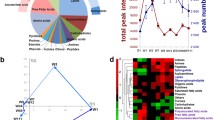Abstract
The fluorescence anisotropy (r) of diphenylhexatriene (DPH) and of trimethylamino-diphenylhexatriene (TMA-DPH) as a function of temperature (10° to 54°C) was measured in brain microsomes of newborn rats prenatally exposed to ethanol. In this temperature range, the relationship between r and T was linear. The addition of ethanol in vitro to microsomal suspensions influenced the slope of the line of r versus T only when DPH was used as a probe and with high concentrations of the alcohol (≥0.3 M).
The administration of ethanol (18% of total energy intake) in vivo to pregnant dams affected the slope of the lines of r versus T of the microsomes of pups, either using DPH or TMA-DPH as probes. The slope was also affected in brain microsomes obtained from dams, yet, only with TMA-DPH and in the opposite sense than in pups. We conclude that the effect of prenatal exposure to ethanol depended on metabolic alterations induced by the alcohol and not on its detergent properties for the following reasons: (a) The effects in vitro and in vivo were different and (b) in vitro effects could be obtained only with high concentrations (≥0.3 M), whereas in vivo effects were produced by small doses of ethanol. Besides, the effects of the administration of the alcohol in vivo were different in adult and intrauterine life.
Similar content being viewed by others
Abbreviations
- DPH:
-
1,6-diphenyl hexa-1,3,5-triene
- HEPES:
-
4-(2-hydroxyethyl-1-piperazineethansulfonic) acid
- SHB:
-
sucrose-HEPES-buffer (0.32 M sucrose, 2 mM HEPES, pH 7.0)
- TMA-DPH:
-
1-[4-(trimethylamino)phenyl]-6-phenylhexa-1,3,5-triene, p-toluensulfonate
References
Rosset, H. L., and Weiner, L. 1988. Biochemical and molecular basis of alcohol-induced injury to liver and other tissues. New Engl J. Med. 319:1639–1650.
Naus, C. C. G., and Bechberger, J. F. 1991. Effects of prenatal ethanol exposure on postnatal gene expression in the rat. Develop. Genet. 4:293–298.
Duester, G. A. 1991. A hypothetical mechanism of fetal alcohol syndrome involving ethanol inhibition of retinoic acid synthesis at the alcohol dehydrogenase step. Alcoholism Clin. Expt. 15:568–572.
Garro, A. J., McBeth, D. L., Lima, V., and Lieber C. S. 1991. Ethanol consumption inhibits DNA methylation in mice. Implications for the fetal alcohol syndrome. Alcoholism Clin. Expt. 15:560–564.
Custo, G., Corazzi, L., Mastrofini, P., and Arienti, G. 1987. Glycerol incorporation into brain lipids in rat pups born to ethanolintoxicated dams. Neurochem Res. 12:469–473.
Pistolesi, R., Custo, G., Corazzi, L., Mastrofini, P., and Arienti, G. 1988. The incorporation of intracranially-injected glycerol into brain glycerides of young rats born to normal and alcohol-fed mothers. Neurochem Res. 13:817–821.
Shinitzky, M. 1984. Membrane fluidity and cellular functions. Pages 1–51.in Shinitzky, M. (ed) Physiology of membrane fluidity, vol. 1 CRC, Boca Raton, FL.
Lentz, B. R. 1990. Membrane “fluidity” as detected by diphenylhexatriene probes. Chem. Phys. Lipids 50:171–190
Prendegast, F. G., Haugland, R. P., and Callahan, P. J. 1981. 1-[4-(trimethylamino)phenyl]-6-phenylhexa-1,3,5-trienet synthesis, fluorescent properties and use as a fluorescent probe of lipid bilayers. Biochemistry 20, 7333–7378.
De Carli, L. M., and Lieber, S. C. 1967. Fatty liver in the rat after intake of ethanol with a new liquid diet. J. Nutr. 91:331–339.
Porcellati, G., Arienti, G., Pirotta, M. G., and Giorgini D. 1971. Base-exchange reactions for the synthesis of phospholipids in nervous tissues: the incorporation of serine and ethanolamine into the phospholipids of isolated brain microsomes. J. Neurochem. 18:1395–1417.
Shinitzky, M., and Barenholz, Y. 1978. Fluidity parameters of lipid regions determined by fluorescence polarization. Biochim. Biophys. Acta 515:367–394.
Burton, J., Litman, B. J., and Barenholz, Y. 1982. Fluorescent probes: diphenylhexatriene. Methods Enzymol. 81:678–685.
Lowry, O. H., Rosebrough, N. J., Farr, A. L., and Randall, R. J. 1951. Protein measurement with the Folin phenol reagent. J. Biol. Chem. 193:265–275.
Antunesmadeira, M. C., and Madeira, M. C. 1989. Membrane fluidity as affected by insecticide lindane. Biochim. Biophys. Acta 982:161–166.
Bejanian, M., Alkana, R. L., von Hungen, K., Baxter, C. F., and Syapin, P. J. 1991. Temperature alters ethanol-induced fluidization of C57 mouse brain membranes. Alcohol 8:117–121.
Author information
Authors and Affiliations
Rights and permissions
About this article
Cite this article
Arienti, G., Di Renzo, G.C., Cosmi, E.V. et al. Rat brain microsome fluidity as modified by prenatal ethanol administration. Neurochem Res 18, 335–338 (1993). https://doi.org/10.1007/BF00969092
Accepted:
Issue Date:
DOI: https://doi.org/10.1007/BF00969092




